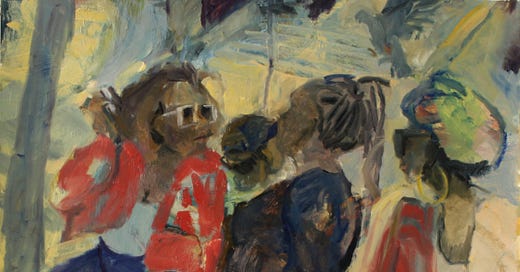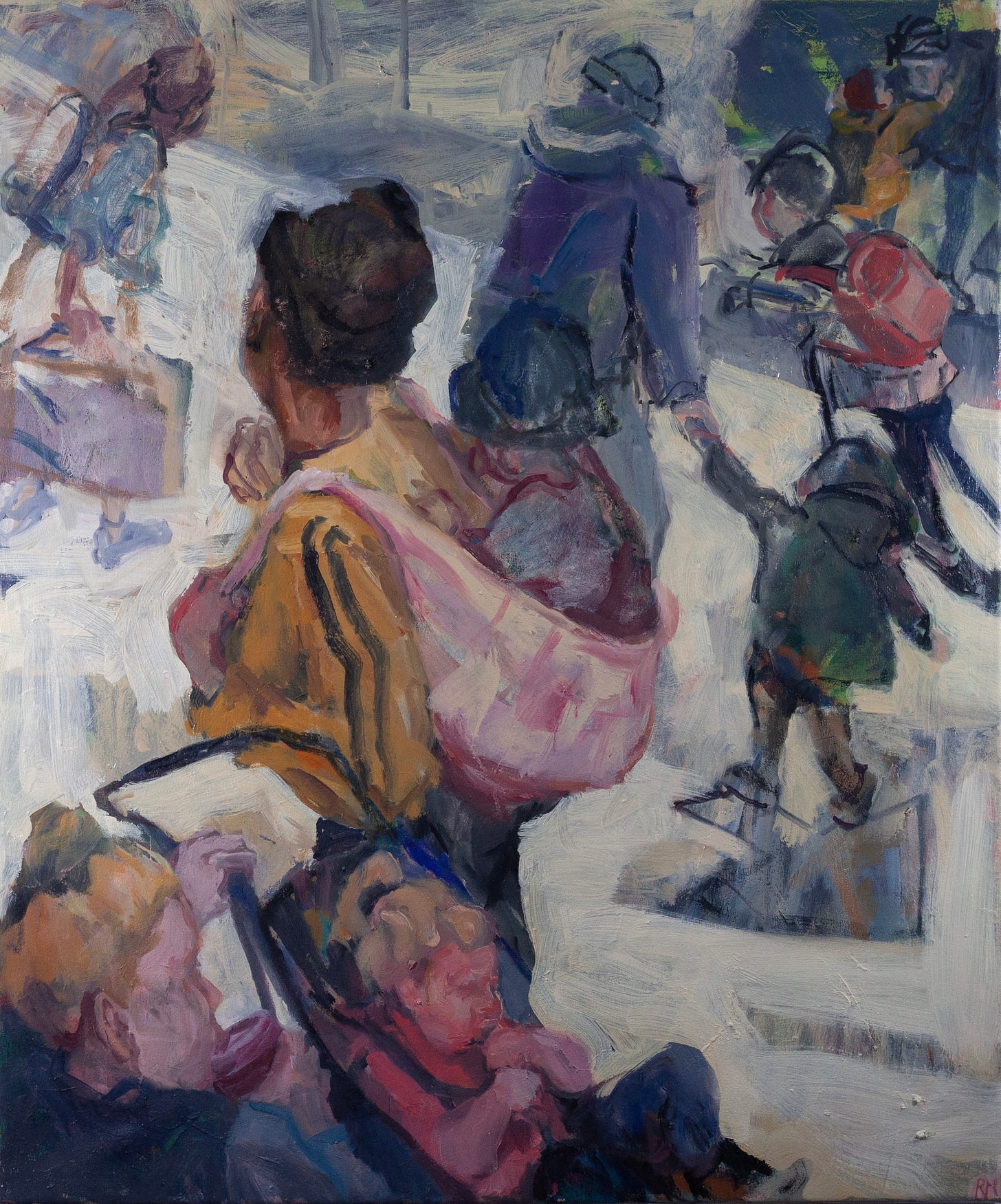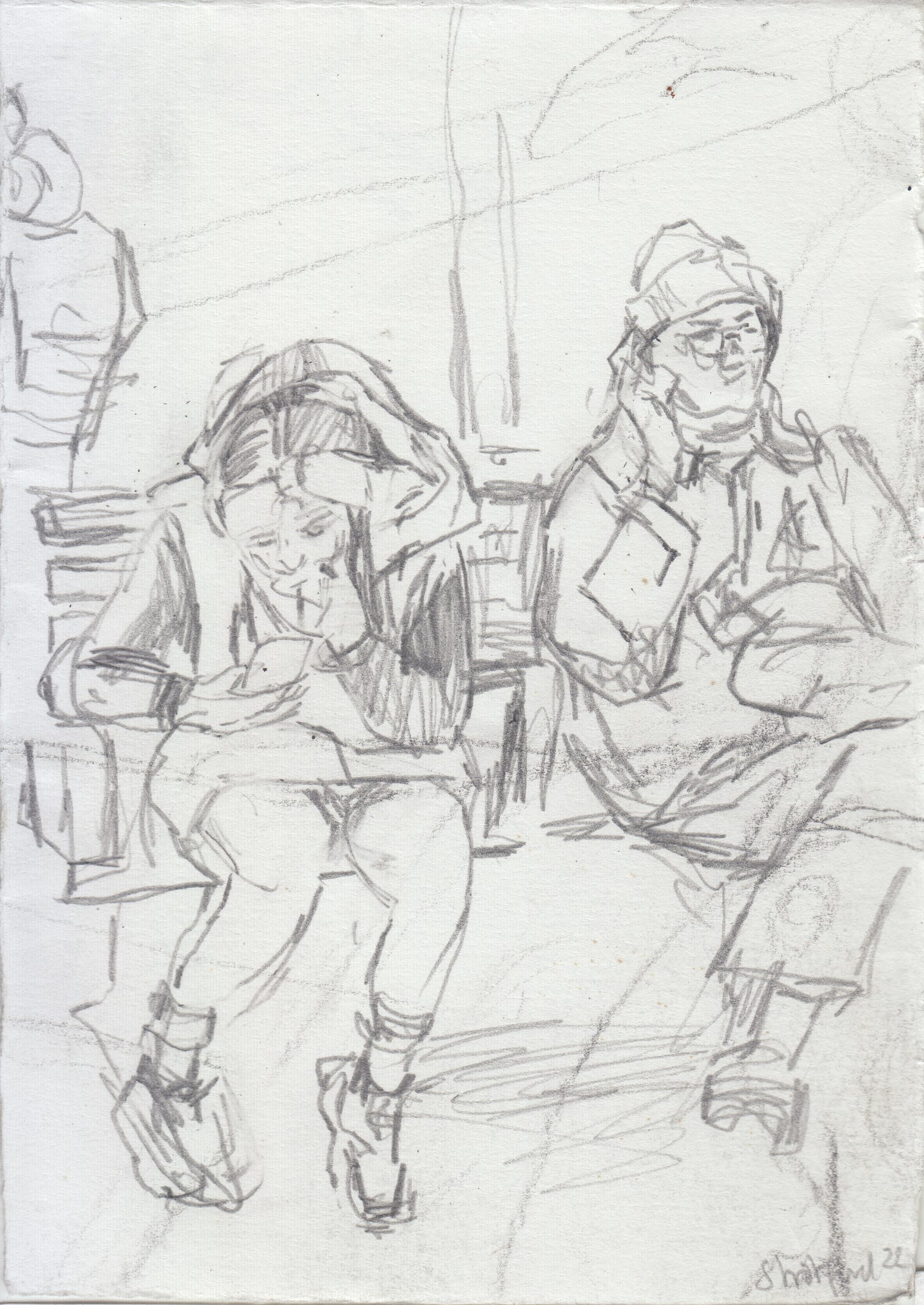Credit: Rachel Mercer, Pigeon, Oil on Board 64x73cm 2023
Hello there,
I have another glorious guest post this week on Fine Things on a Thursday, (though sometimes posted on other days!) - this is a weekly list of recommendations, current obsessions, interests and inspirations posted by either myself or an artistic guest of mine (do check out musician Yova’s from last week)! This week my guest is talented London-based artist Rachel Mercer who currently has a solo exhibition on at The Gallery at Green and Stone - it’s on till Saturday (9th) so do check it out. Without further ado here’s Rachel….
The occasion of a solo show this week seemed a good opportunity to reflect on the most influential five things from the last 12 months. Some of the paintings in my exhibition were begun in January 2023 and now hang together with paintings from January 2024. Seeing them together on the walls of The Gallery at Green and Stone, allows me to see these separate paintings as a body of work, it’s an opportunity to reflect on recurring themes and ideas that went into each of them. Each painting is primarily inspired by what I observe on the doorstep of my Stratford studio. I draw and paint everyday life: the people and shops of the Stratford Centre. My second motivation and interest is a painterly one: what happens on the canvas when working through the medium of paint. My third source of inspiration is everything else that grabs me. I hope that my five things might give readers a greater insight into this series of paintings and maybe encourage them to come see the show in real life before the week ends!
1. Absorbing! If these apples should fall by TJ Clarke
TJ Clark is poetic and thoughtful in his notes of Cezanne’s paintings. You know from reading this book that TJ Clarke is a man who really spends a long time looking – REALLY looking at paintings. The book comprises of 5 essays. Essay 1 ‘The Material of Cezanne’ gives a personal view into Cazanne’s still-life paintings. He highlights Cezanne’s exploration of fabric and surfaces a unique phenomenology ‘the world pictured as possessed by the eye’.
This essay as well as the essay on Cezanne’s card-player series really informed the way I engaged with textures and surfaces in my observations but also the way I empathised with the people who I was drawing and painting. (Link to book here.)
2. Reading! ‘A Little Larger Than The Entire Universe’ a collection of poems by Fernando Pessoa translated by Richard Zenith (Penguin 2006)
Pessoa is a fascinating poet who used five characters/ pennames to distinguish different writing styles and themes for his poems. His poems are full of imagery that tries to capture human experience, both the everyday and the metaphysical.
Here is one poem from the collection that has particularly influenced me. Its title became the title for my exhibition. The poem is critical of the cities and perhaps reflects a view I once held (being born a country bumkin). Now, however (after 10 years of living in the city) I find the ‘locked up views’ has presented their own wealth of seeing. I find the experience of feeling small in the city humbling – simultaneously remining us of our own insignificance but also our responsibility to others. (Pessoa’s collection here.)
In the Cities life is Smaller
by Fernando Pessoa
From my village I see as much in the Universe as you can see from earth,
And so my village is as large as any town,
For I am the size of what I see
And not the size of my height...
In the cities life is smaller
Than here in my house on top of this hill.
The big buildings of cities lock up the view,
They hide the horizon, pulling our gaze far away from the open sky.
They make us small, for they take away all the vastness our eyes can see,
And they make us poor, for our only wealth is seeing.
3. Learning! from ‘So Much Longing In So little Space’ by Karl Ove Knausgaard
This fantastic book is informative if you are interested in the life and work of Edvard Munch. But what is most interesting is Knausgaard’s own musings of creativity and his thoughtful interpretations of Munch’s paintings. He discusses the look and the longing of Munch’s sitters and subjects. I was reading this book at the same time as I was making a series of drawings of stall sellers in the Stratford Centre. I would ask the stall owners if I could draw them, some stayed relatively still, while others continued in their work or engaged in conversation. I am interested in how one captures the longing (and perhaps hope) of a stranger in a portrait.
Listening! I was first introduced to Pessoa by a podcast by Simon Critchley ‘Apply-Degger’
A series of podcasts that go through Heidegger’s ‘Being and Time’ chapter by chapter. Admittedly I felt I was out of my depth (and/or reached Heidegger-saturation-point) by Chapter 4. However, Critchley was engaging and skilful when breaking down this dense and challenging ideas.
I was interested in Heidegger and phenomenology in general because it is the area of philosophy that explores lived experience, including our perception of the world around us. This is what I am most interested to explore through my images.
5. Looking! at Holbien at the Tudor Court
These drawings by Holbien are exquisite. Coming to face to face with them is literally mind-altering, an amazing example of how art can literally rewrite consciousness. Seeing these in reproduction doesn’t come close to the experience of seeing them in real life. These drawings reminded me that the image of the human, made my another human is a powerful and existential experience when done right.
Credit: Rachel Mercer. Charge, Oil on Canvas 120x100cm, 2023.
Other….
My five things culminates in a text written by Julian Bell for the foreword of my exhibition catalogue. Julian Bell is a fantastic writer; he has written books on Van Gogh Bonnard as well as a recent history of art titled ‘Mirror to the World’ you can find his books (published by Thames and Hudson) here.
Julian was one of my lecturers at the Royal Drawing School (2012-13) I have admired Julian’s writing (and his paintings) for long time so I was honoured and delighted that he agreed to write something for me. His visit to my studio was invigorating and his response to the work has really given me at kick to push onward.
Here is frontline figure painting for the 2020s - raw with a kick, like a jump in cold water. A subtle mind takes a running leap into the Eastend's shopping centre cum indoor market, the Stratford Centre. Look at the way the foot of a scrapping schoolkid alights on the canvas edge in Duel. That's awkward, in a sense. It prods us: 'This is a made rectangular object, remember. Not a photodocumentary, but a bunch of muscular decisions taken in tight confines. We're jolted from our smiling at a street comedy of rolled-up papers weaponized, our empathy with that blurry onlooker we glimpse foreground left. A blurriness that's awkward also - but likewise, it's a reality check. 'I paint what got through to me', Rachel Mercer implies, 'not what didn't.' Because before and after showing us the street, a painting will always be mind aligned with muscle.
What sly moves that combination makes here. Plunging into the Stratford Centre, built in 1974 (pre-Westfield and Olympic developments), the painter is stripped of the fallback handhold of tone. Overhead lighting systems and gleaming flooring minimize the gradations that suggest body volume and spatial recession. Puffa jackets and sportswear further compact the human units, the customer footfall, into so many cut-outs. Mercer's eye swims in and out and right up close between those units - see her terse snatched sketches - and then in her studio she restages the shock of encounter in blurts and forward bounds. Brushwork that wins brawls with itself. Look how the other fighter, or the righthand woman in Pigeon - the one with the red trolley - declare themselves at us, instantly readable, almost in contradiction of the colour information. Manet and Rembrandt would respect what's happening there.
Figure painting is old and new and forever. People paint people wondering what entities they themselves are. Odd activity, undeniably, and potentially uncomfortable - who does this human drone think she is, swooping in among the East End consumers? But that question is close to what Mercer's asking herself. What is there for her to know of the mother with the baby carrier in Charge? Neither her face, maybe, nor her name. What matters more deeply, however, is what both women share: strength to stand, strength to bear, animation, mobility. Fellow-feeling drives these unruly, lively paintings. Pretty is not what they aim at. Where they touch down is joy.
Julian Bell, March 2024
Credit: Rachel Mercer. Study of Bench. Drawing 10.5 x 14.8cm 2023
Thank you so much to Rachel for these wonderful and inspiring Fine Things! I for one will be checking them out as well as her upcoming show at The Gallery at Green and Stone (251 - 253 Fulham Road, London, SW3 6HY) which ends this Saturday (March 9th at 5pm). For all sales and enquires you can contact the gallery directly here: +44 (0) 207 352 0837 or here thegallery@greenandstone.com. You can also keep up to date with Rachel here and check out her website here. Finally, if you would like a full-colour copy of the gorgeous catalogue (containing all the works exhibited and text by Julian Bell ) for £5 (including p&p) then please email Rachel at: mercer@rachelmercerartist.com
Oh and please do share, subscribe, like, comment, and all that. Thank you very much! Over and out!
Love,
Emma x o x
p.s. for more After the Fact find literary flotsam and jetsam here, fiction here and personal essays here.






